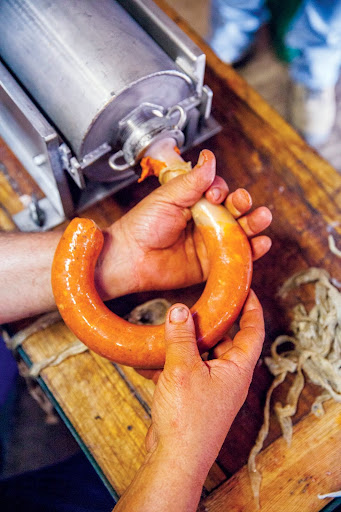Charcuteria: A Slice of Delicious Spanish Life and Traditions
Charcuterie, meaning “pork butchery” in French, has traditionally been sandwiched into many American menus. But while most chefs know how to craft French and Italian style charcuterie, they don’t know much about Spain’s ancient culinary art form.
Now, in his new book, Charcutería: The Soul of Spain, Jeffrey Weiss slices past butchering, meat-curing, and seasoning techniques to introduce American chefs and charcuterie lovers to Spain’s unique tradition.

It’s the first book of its kind to introduce Americans to every aspect of Spanish charcuterie. Weiss not only explains pig raising and the pig slaughter, he relates the pig’s impact on daily life. From political banners and symbols of prosperity to pork festivals, the pig’s importance is evident.
Weiss wants readers to get the whole picture, so he includes charcuterie-infused recipes. Two of my personal favorites are: croquetas de Jamón (ham croquettes) and cocido Madrileño (veggie and pork stew). Desserts, liquors, purveyors, and a glossary of Spanish words used in the book are also included.
The colorful 468-page book feels more like a college textbook rather than a traditional cookbook, but it’s neither. Instead, it’s a detailed guide aimed at anyone interested in learning how to make Spanish charcuterie while learning about Spain’s cuisine, culture, and history.
“To me, it’s more than a cookbook. The point is not to just give recipes; it’s to show the history and culture of the Spanish people. So I’d say it’s part cookbook, part storybook, and part history,” said Weiss by telephone from Jeninni’s Kitchen, his restaurant in Pacific Grove, California.

Weiss sprinkles his detailed narrative with precise Spanish words that show mouthwatering differences between French and Italian techniques and those used to make fresh, semi-cured, dry-cured, and whole muscle Spanish Charcutería.
In 2009, Weiss was one of 10 chefs worldwide who received a year-long scholarship for a training program in Spanish gastronomy. Since he had visited and fallen in love with Spain years earlier, the scholarship aligned with his career as a chef.
“I had visited my sister who was living there years before. But this was the first food-intensive visit. So the ICEX (ICEX is an organization in Spain's Ministry of Economy that promotes exports and investments in Spain and abroad. The scholarship is one of its program that helps in this effort.) scholarship was a natural progression,” said Weiss, whose early years were shaped by chef Steve Chan at the Lion & Compass restaurant in Sunnyvale.
In reading Charcutería, it’s clear he’s a “Spainophile” who has included Spanish charcuterie in his own restaurant menu. Some Spanish offerings include higado de pollo paté (chicken liver paté), mojama (cured tuna loin), and embutidos (sausages).

In the book, he details each cut, including Spanish mainstays like Jamón Serrano and Chorizo, so that you can practically taste the pimentón, garlic, and other spices not usually used in the charcuterie Americans consume.
He also chronicles the life of the black-hoofed pig responsible for the famously expensive Jamón Iberico. Weiss highlights the particular customs used in making sausages and hams in each region he visited, including Castilla-La Mancha, Malaga, Asturias, and Extremadura.

“I don’t expect everyone who picks up Charcutería to set up a curing chamber and start hanging legs of pork, while I encourage it, if that’s your thing. One of the major reasons I wrote the book was to help communicate the incredible story that Spain and Spaniards tell through their cuisine and culture,” said Weiss.
Vibrant color photographs by James Beard Foundation nominee Nathan Rawlinson highlight some of Spain’s bucolic landscapes. His photographs include pig slaughterers called matanceros in blue overalls and the sabias, wise women who stir the pig’s blood and help stuff sausage casings.

Sergio Mora’s comical pig illustrations tempers what could be a distasteful experience for some readers, but probably not chefs. After all, chefs on this side of the Atlantic have been preparing charcuterie French and Italian styles for decades.
Now, thanks to Weiss, American chefs may understand more about what it takes to make morcilla (blood sausage) and the Catalonia region’s butifarra. Chefs and readers alike will learn new ways of making delicious charcuterie.

Spanish chef Jose Andres, voted “Outstanding Chef” in 2011 by the James Beard Foundation, wrote the book’s foreword. He met Weiss when he joined his restaurant staff. Andres recommended Weiss for the culinary scholarship from ICEX.
“Charcutería brings to life-with real heart, history and technique-an astonishing look at the legacy of Spain’s flavorful meats,” writes Andres, whose Jaleo restaurant in Washington, D. C., served as a life-changing inspiration to Weiss.
“This book perfectly marries the necessary techniques of brining, salting, fermenting, and drying with the exceptional stories of Spain’s particular animals. It connects the past to the present, and I know it will open up the door to new possibilities for what you can create at home,” Andres adds.
While on scholarship, Weiss had the opportunity to live in and travel throughout different regions in Spain. While in Spain, Weiss cooked alongside Andalusian chef Dani Garcia, the first to develop the culinary use of liquid nitrogen.
“During my scholarship with ICEX, I was given a choice of places to work. So I could have gone to work at El Bulli. But after talking to Jose (Andres), I decided to go see Dani Garcia in Marbella. Dani is an innovator, and I wanted to learn the foundation of Spanish cuisine,” said Weiss, who also worked with Adolfo Munoz in his restaurant in Toledo and Carlos Tristancho at Rocamador, his hotel in Extremadura.
In his book, Weiss recounts in-depth instances in which the slaughtering of the pig was both a solemn and celebratory ritual.The entire project never lacked delicious food and plenty of wine or liquor, Weiss recounts. Nevertheless, the bloody matanza (killing) takes the uninitiated aback. But Weiss narrates his experiences with humor and anecdotes that help the reader get through it.
He’s well versed on how Charcutería started and evolved into a modern-day culinary industry. In his travels, Weiss discovered the Spanish prefer to use spices such as garlic and pimentón instead of nutmeg, allspice, and other Medici spices used in American charcuterie.
Even for those who just want to enjoy embutidos in the form of chorizo, the book takes you on a colorful, behind-the-scenes journey through Spain. For anyone who has visited Spain, you know that each region is a world all its own. That is why the first trip to Spain can never be your last.
Charcutería: The Soul of Spain sells for $39.95 a copy. Evanston, Illinois-based Agate Publishing Inc. has made the book available through Amazon.
Rosie Carbo is the Lifestyles Editor for Wandering Educators, and is a former newspaper reporter whose work has appeared in newspapers and magazines nationwide. Some of those publications include People magazine, The Dallas Morning News, The Houston Chronicle and San Antonio Express-News. Some of her features were redistributed by The Associated Press early in her career as an award-winning Texas journalist.
All photos courtesy and copyright Nathan Rawlinson
Note: We received a review copy of this book from Agate Publishing – thank you!
-

- Log in to post comments



















